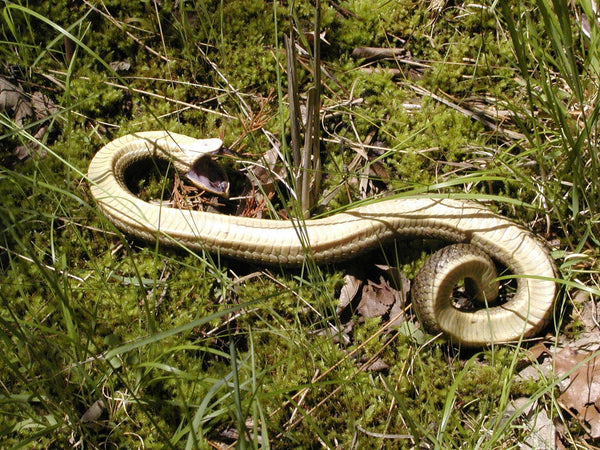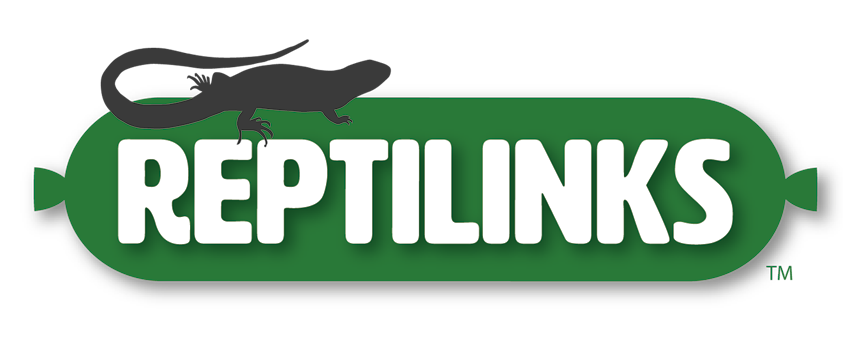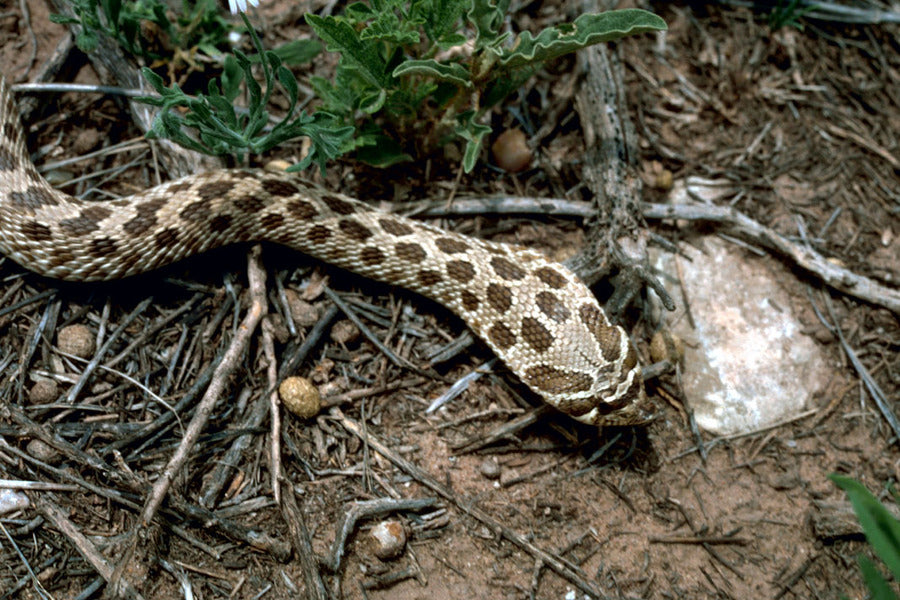17 Frequently Asked Questions About Hognose Snake Care
By Nick Helble

Although they aren’t currently the most popular choice of pet, more and more reptile enthusiasts are becoming interested in raising a hognose snake. Truthfully, there’s a lot to love about these underrated members of the snake family: their upturned nose, their wide and goofy grin, and the adorable way they play dead like a puppy.
But why are hognose snakes the way they are? What’s the purpose of their unusual features and characteristics? And how do you take care of a hognose snake pet? We’ve collected answers to some of the most common questions related to these wonderful creatures, as well as the most important facts relating to hognose snake care.
Check it out below:
What is a hognose snake?
The term ‘hognose snake’ can refer to several different species of snake that share similar characteristics— namely, their upturned hoglike nose. Some of these species are named after the regions where they live, such as the Eastern hognose snake or the Mexican hognose snake. Others are named after specific defining features, such as the Speckled hognose snake or the Tricolor hognose snake. Ultimately, the most popular species found as pets (and the main focus of this article) are the Western, Eastern, and Southern hognose snakes.

An Eastern hognose snake in Wisconsin. Photo taken by Alex Harman and uploaded to iNaturalist.
What does a hognose snake look like?
As its name implies, a hognose snake’s most distinguishing feature is its wide head with an upturned nose. This shovel-like head shape allows it to dig in sand or soil when scavenging for food. Additionally, the range of colors and scale patterns can vary, even among the same species. However, the majority of them will be between two and three feet long as adults, with females typically growing larger than males.
What does a baby hognose snake look like?
For the most part, baby hognoses look like smaller adult hognoses. However, the average size of a hognose hatchling can vary depending on the species. For more info on general size differences between hognose snakes, take a look at the table below:
Hognose Snake Size Chart
|
Species |
Western Hognose Snake |
Eastern Hognose Snake |
Southern Hognose Snake |
|
Hatchling Size |
5 to 9 inches |
6½ to 8 inches |
6 to 7 inches |
|
Adult Male Size |
14 to 24 inches |
17 to 24 inches |
13 to 15 inches |
|
Adult Female Size |
28 to 36 inches |
28 to 36 inches |
18 to 22 inches |
Source: Animal Diversity Web
Where do hognose snakes live?
Hognose snakes can be found in many locations all over North America, as well as a few in South America. Additionally, the names of many hognose species denote where they live. Typically, Western hognose snakes can be found in Southern Canada, the American Midwest, the American South, and Northern Mexico. Eastern Hognose snakes can be found in Ontario, Wisconsin, Florida, Minnesota, Texas, Kansas, and New Hampshire. Southern hognose snakes can be found in Florida, Mississippi, and North Carolina.
Five points if you can correctly guess where Mexican hognose snakes live!
How long do hognose snakes live?
Hognose snake lifespan can vary depending on the specific species, with many Southern and Eastern hognose snakes having an average lifespan between 5 and 9 years. In comparison, Western hognose snakes have much longer lifespans and can live as long as 20 years in captivity.
Are hognose snakes venomous?
Most varieties of hognose snakes are considered harmless to humans and are generally referred to as non-venomous. Truthfully, hognose snakes can produce a mild venom, but this is only harmful to small creatures like toads and mice. Even Madagascar hognose snakes — a species notorious for its venomous properties due to its habitat — still only produces a mild amount that won’t cause serious damage to a human.
Why do hognose snakes play dead?
As previously mentioned, hognose snakes are mildly venomous. This means that while they can effectively subdue their own prey, they aren’t as effective at warding off predators. Hence, they will often play dead and emit foul smells to prevent predators from wanting to take a bite. This is especially common among Eastern hognose snakes, but Western hognoses have also been known to do this.

An Eastern hognose snake playing dead in Arkansas. Photo taken by Kory Roberts and uploaded to iNaturalist.
Do hognose snakes make good pets?
Yes! Hognose snakes are some of the best pets for reptile enthusiasts. In fact, they’re an excellent compromise snake; they’re more exotic than a gecko but less fussy than a ball python. When considering the wide variety of morphs, their adorable faces, and the fact that they can play dead, it’s no surprise that Western hognose snakes are becoming more and more popular as pets. That isn’t to say that Eastern or Southern hognoses aren’t good pets, just that Western hognoses are slightly more popular due to their longer lifespans.
Are hognose snakes good for beginners?
Yes and no. If you’re a complete beginner to keeping any pet reptiles, you’re probably better off starting with a gecko; they’re more easily handled and less picky with their diet. However, these do make for excellent pets for first-time snake owners since they’re slightly less picky than ball pythons. With that being said, corn snakes are generally considered the best pet snake for beginners, although hognoses aren’t much more difficult.
Are hognose snakes legal in Australia?
Currently, it is illegal to own exotic animals as pets in Australia. That means that hognose snakes that are native to North America, including Western, Eastern, Southern, and Mexican hognose snakes, cannot be legally kept as pets in Australia. However, the NSW Native Animal Keeper Species List does allow for Eastern shovel-nosed snakes to be kept as pets, which are similar in some aspects to hognoses. Before getting one as a pet, however, you should contact the Australian Department of the Environment and Energy.
Are hognose snakes legal in Canada?
Currently, only Western hognose snakes can be legally kept as pets in Canada. This is because the country has similar laws to Australia when it comes to exotic and invasive species. According to Manitoba law, raising exotic species that are either wild or in captivity is highly regulated and can result in legal action. This excludes the Eastern, Southern, and Mexican hognose snake, although some types of Western hognose are native and therefore legal. However, you should still contact the Canadian Wildlife Service before acquiring one.

A plains hognose snake in Manitoba, Canada. Photo taken by Neil Balchan and uploaded to iNaturalist.
Where can I buy a hognose snake?
Hognose snakes can be purchased from a retail pet store, although they may be rare to find in stock due to their diminished popularity compared to other reptiles. Additionally, there are breeders who sell specific morphs and species of hognose, although this is usually the more expensive option. Additionally, you’ll need to do your due diligence when purchasing through a breeder; check reviews from other customers, ask questions to ensure they’re acquiring and raising their hognoses ethically, and find out if they can ship the animal to your area.
How much are hognose snakes?
As previously mentioned, hognose snake prices can vary based on the specific species, morph, and breeder or retailer. That being said, the average price for an albino Western hognose snake online is around $200, which is pretty affordable for a snake. Alternatively, specialized morphs can cost anywhere between $300 and $700, with some even costing more than $1,000.
What do hognose snakes eat?
Hognose snakes are carnivorous and can eat a variety of creatures. The most common meal in the hognose snake diet is amphibians like frogs and toads; they’re highly susceptible to their venomous bites. However, they can also eat mice, bugs, and both lizard and bird eggs. When kept as pets, it’s a good idea to feed your hognose whole mice (frozen, not living!) with Frog Juice for flavor. We also recommend our Frog & Rabbit, Iguana, or Frog Micro and Mini links for a balanced meal.

A Southern hognose snake eating a frog in Florida. Photo taken by Joshua Doby and uploaded to iNaturalist.
What do baby hognose snakes eat?
Baby hognose snakes have been known to eat insects in the wild, as well as some small rodents and amphibians. When feeding your own hognose snake hatchling, we recommend frozen pinky mice with Frog Juice or Frog Micro and Mini links.
How often should I feed my hognose snake?
When managing a baby hognose snake diet, it’s generally recommended that you feed it every 5 or so days. Once it grows into an adult, you can space out feeding sessions to once every week or every 2 weeks. Remember to only feed your hognose snake appropriately-sized meals to avoid regurgitation. Additionally, you should avoid touching or agitating your hognose snake for one to two days after feeding so that it can digest its meal.
Why isn’t my hognose snake eating?
There are several reasons why your hognose snake isn’t eating. It’s important to ensure that you’re feeding your hognose the correct kind of food in the correct size. Additionally, the size of your hognose snake enclosure and its decorations can affect your pet’s appetite. However, the most significant factor that can affect your snake’s ability to eat is ambient temperatures and brumation. For a more detailed breakdown of all of these factors, check out our blog post for tips on getting your hognose snake to start eating again.
Hopefully, this information has inspired you to add a hognose snake to your family! If you have any questions that we didn’t cover here, feel free to continue the conversation by leaving a comment or contacting us. Thanks for reading!
Sources
- https://www.inaturalist.org/
- https://animaldiversity.org/accounts/Heterodon_nasicus/
- https://animaldiversity.org/accounts/Heterodon_platirhinos/
- https://animaldiversity.org/accounts/Heterodon_simus/
- https://www.fws.gov/southeast/wildlife/reptiles/southern-hognose-snake/#recommended-conservation-measures-section
- http://www.toxinology.com/fusebox.cfm?fuseaction=main.snakes.display&id=SN1531
- https://archive.org/details/audubonsocietyfi00behl
- https://www.floridamuseum.ufl.edu/herpetology/fl-snakes/list/heterodon-simus
- https://www.floridamuseum.ufl.edu/herpetology/fl-snakes/list/heterodon-platirhinos/
- http://www.thehognosesnake.co.uk/hognose_snake_care_sheet.htm
- https://www.cbsnews.com/news/zombie-snake-hognose-found-in-eastern-us-can-roll-over-and-play-dead/
- https://www.madamagazine.com/en/die-madagaskar-hakennasennatter/
- https://www.environment.nsw.gov.au/-/media/OEH/Corporate-Site/Documents/Licences-and-permits/nsw-native-animal-keepers-species-list.pdf
- http://web2.gov.mb.ca/laws/statutes/ccsm/w130e.php
- http://www.herpnet.net/Iowa-Herpetology/reptiles/snakes/plains-hognose-snake-heterodon-nasicus/
- http://www.herpnet.net/Iowa-Herpetology/reptiles/snakes/eastern-hognose-snake-heterodon-platirhinos/
- http://www.thehognosesnake.co.uk/hognose_snake_care_sheet.htm
- http://www.lihs.org/files/caresheets/Heterodon.htm


2 comments
This was very helpful
It should be noted that Hognose snakes play dead as a last resort and will be accepting the fate of death when this point is reached, so to anyone looking to buy a hognose like me, PLEASE don’t make a hognose play dead! (Exceptions being that hatchlings may play dead when first having human contact as they don’t know what humans are. Be smart and do research regarding snakes of any kind you’re interested in owning.)